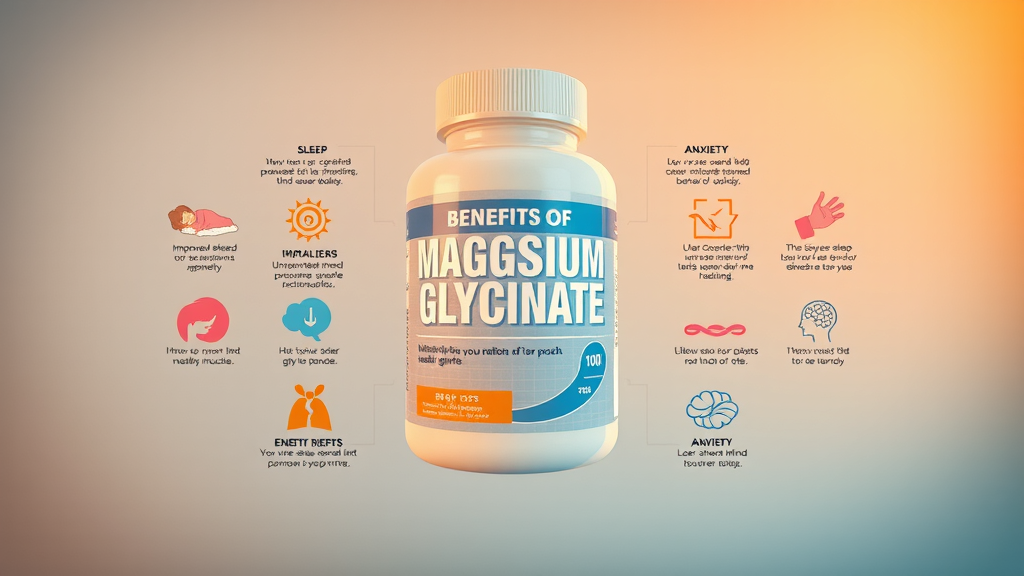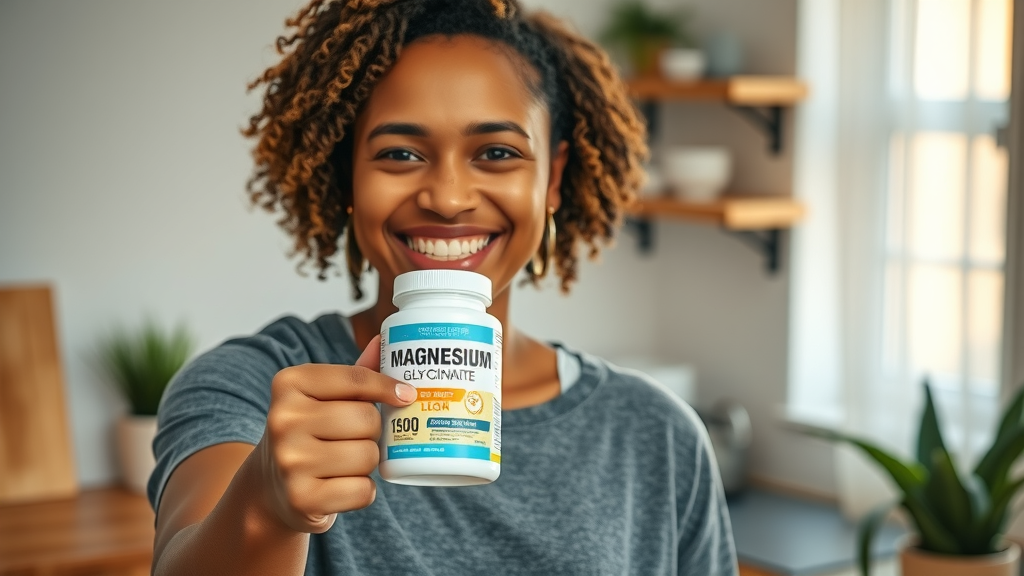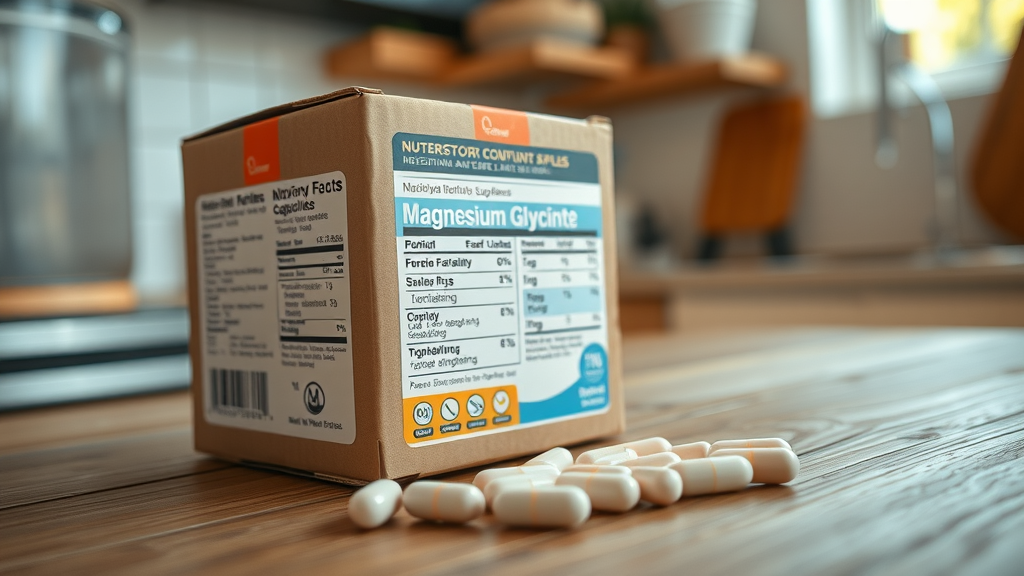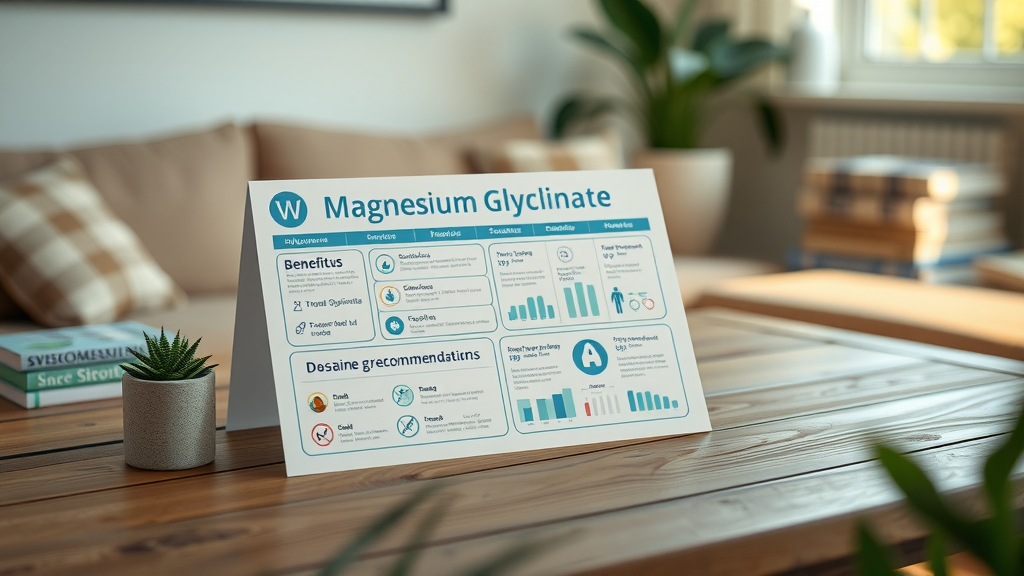Struggling to catch those elusive Zs? You’re not alone! In a world where sleepless nights are the norm, understanding the power of Magnesium Glycinate can transform your rest and rejuvenation. This article, “Unlock Better Sleep: The Surprising Benefits of Magnesium Glycinate,” dives deep into why this often-overlooked mineral is your secret weapon against insomnia and stress. Discover how mastering Magnesium Glycinate can lead to deeper sleep, improved mood, and a healthier you. Ready to reclaim your nights? Let’s explore!
What is Magnesium Glycinate?
The Importance of Magnesium in the Body
Magnesium is an essential mineral that plays a critical role in numerous bodily functions, including muscle and nerve function, energy production, and bone health. It helps regulate various biochemical reactions in the body, including those involved in blood pressure regulation and muscle function.
Here’s a quick overview of the roles of magnesium in the body:
Supports Muscle and Nerve Function : Magnesium aids in muscle contraction and relaxation.
Contributes to Bone Health : It works with calcium to maintain strong bones.
Regulates Blood Sugar Levels : Magnesium helps manage insulin and blood sugar levels.
Promotes Heart Health : Adequate magnesium intake is linked to better cardiovascular health.
Magnesium Glycinate vs Other Forms of Magnesium
Magnesium Glycinate is a specific form of magnesium chelated with the amino acid glycine. This combination enhances its absorption and bioavailability compared to other forms, such as Magnesium Oxide or Magnesium Citrate.
Form of Magnesium |
Absorption Rate |
Common Uses |
|---|---|---|
Magnesium Glycinate |
High |
Anxiety, Sleep Disorders |
Magnesium Citrate |
Moderate |
Constipation Relief |
Magnesium Oxide |
Low |
Digestive Issues |
“Magnesium Glycinate is often recommended for its superior absorption and calming effects.”

Health Benefits of Magnesium Glycinate
Bone Health and Muscle Function
Magnesium Glycinate contributes significantly to bone health by aiding in calcium absorption, thus preventing bone-related diseases such as osteoporosis. Additionally, it supports muscle function by helping to prevent cramps and spasms.
Helps maintain strong bones.
Reduces the risk of muscle cramps.
Supports overall muscle function.
Cardiovascular Health and Blood Pressure Levels
Magnesium Glycinate is crucial for maintaining heart health. It helps regulate blood pressure levels and can reduce the risk of cardiovascular diseases.
Supports healthy blood pressure.
Reduces the risk of heart disease.
Promotes healthy circulation.
Nervous System Support
Magnesium is known to support the nervous system , which can help alleviate anxiety and improve mood. Magnesium Glycinate is often favored for its calming effects.
Calms the nervous system.
Reduces symptoms of anxiety.
Promotes better mental health.
Improving Sleep Quality
One of the most touted benefits of Magnesium Glycinate is its ability to improve sleep quality. It promotes relaxation and helps regulate sleep patterns.
Enhances deep sleep.
Reduces insomnia symptoms.
Promotes a restful night.
Managing Stress and Anxiety
Magnesium Glycinate has been shown to help manage stress and anxiety levels, making it a popular choice for those looking to improve their mental well-being.
Reduces stress and anxiety.
Supports emotional stability.
Promotes relaxation.

Recommended Dosage and How to Take Magnesium Glycinate
Recommended Amount of Magnesium
The recommended dietary allowance (RDA) for magnesium varies by age and sex. For most adults, it ranges from 310 to 420 mg daily.
Age Group |
Recommended Daily Amount |
|---|---|
Men (19-30 years) |
400-420 mg |
Women (19-30 years) |
310-320 mg |
Pregnant Women |
350-400 mg |
Daily Intake and Best Practices
When taking Magnesium Glycinate , it’s best to follow these guidelines:
Take with food to enhance absorption.
Split doses throughout the day for better results.
Consult your healthcare professional for personalized advice.
“For optimal absorption, take Magnesium Glycinate with a meal.”

Potential Side Effects of Magnesium Glycinate
Common Side Effects
While Magnesium Glycinate is generally safe, some may experience side effects, particularly when taken in excessive amounts. Common side effects include:
Diarrhea and loose stools.
Stomach upset.
Nausea.
Serious Side Effects and Precautions
In rare cases, excessive magnesium can lead to more serious health issues, such as:
Irregular heartbeat.
Low blood pressure.
Respiratory distress.
Consult Your Doctor
It’s crucial to consult your healthcare provider before starting any new supplement, especially if you have underlying health conditions or are taking other medications.

Forms of Magnesium Glycinate: Capsules vs Powder
Capsules vs Powder Form
Magnesium Glycinate is available in both capsule and powder forms. Capsules are convenient and easy to take, while powder can be mixed into drinks.
Form |
Pros |
Cons |
|---|---|---|
Capsules |
Easy to swallow |
Fixed dosage |
Powder |
Customizable dosage |
Requires mixing |
Choosing the Right Form for You
Your choice between capsules and powder may depend on personal preference and lifestyle. Consider factors like convenience, dosage flexibility, and ease of use when making your decision.

Magnesium Glycinate in a Balanced Diet
Food Sources of Magnesium
In addition to supplements, you can obtain magnesium from dietary sources. Foods rich in magnesium include:
Leafy greens (spinach, kale)
Nuts and seeds (almonds, pumpkin seeds)
Whole grains (brown rice, quinoa)
Legumes (beans, lentils)
Supplementing with Magnesium Glycinate
While a balanced diet is essential, many people may still find it challenging to meet their magnesium needs. In such cases, Magnesium Glycinate supplements can be beneficial.

User Reviews and Testimonials
Customer Experiences with Magnesium Glycinate
Many users report positive experiences with Magnesium Glycinate , particularly regarding its impact on sleep quality and stress reduction.
“I sleep so much better since I started taking Magnesium Glycinate!”
“It really helps with my anxiety levels.”
Expert Opinions on Magnesium Glycinate
Experts often recommend Magnesium Glycinate for its superior absorption and calming properties, making it a popular choice among healthcare professionals.

Where to Buy Magnesium Glycinate
Online vs In-Store Purchases
You can purchase Magnesium Glycinate from various retailers, both online and in brick-and-mortar stores. Online shopping often provides a wider selection and better deals.
Evaluating Quality and Brand Reputation
When buying supplements, it’s crucial to choose reputable brands. Look for third-party testing and certifications to ensure product quality.
Free Shipping Options
Many online retailers offer free shipping, which can save you money on your purchase.

Privacy Policy and Customer Service
Understanding Privacy Practices
When purchasing supplements online, it’s essential to understand the company’s privacy policy. Ensure your personal information is protected.
Customer Service and Support
Good customer service can make a significant difference. Look for companies that offer easy contact methods and responsive support.
Contacting for Inquiries
If you have questions about a product, don’t hesitate to reach out. Most reputable brands have dedicated customer service teams to assist you.
Email Communications and Customer Rights
Always read the terms and conditions regarding email communications and your rights as a customer.

Key Takeaways
Magnesium Glycinate is an essential supplement for improving sleep quality and managing stress.
It supports bone health, cardiovascular health, and muscle function.
Available in both capsule and powder forms, it offers flexibility based on user preference.
Always consult with a healthcare professional before starting any new supplement.

Frequently Asked Questions
Q: What is the best time of day to take Magnesium Glycinate?
A: Many people find it beneficial to take Magnesium Glycinate in the evening to aid sleep.
Q: Can I take Magnesium Glycinate with other supplements?
A: Yes, but consult your healthcare provider to avoid potential interactions.
Q: Is Magnesium Glycinate safe for pregnant women?
A: Pregnant women should consult their healthcare provider before starting any new supplement.
Conclusion
In conclusion, Magnesium Glycinate is a powerful supplement that can significantly enhance sleep quality, manage stress, and support overall health. By incorporating it into your routine, along with a balanced diet rich in magnesium, you can unlock a healthier, more restful life. Remember to consult your healthcare professional for personalized advice and recommendations!
Key Takeaways:
- Magnesium Glycinate improves sleep quality and reduces anxiety.
- It supports bone and cardiovascular health.
- Available in both capsule and powder forms.
- Consult with a healthcare provider for personalized dosage.
Ready to reclaim your sleep? Consider adding Magnesium Glycinate to your wellness routine today!
Call us at 984-238-6164 or check out our website at https://MyWellnessTrain.com/Network
Feel free to reach out with any questions or for further information on incorporating Magnesium Glycinate into your health regimen!
 Add Row
Add Row  Add
Add 




Write A Comment